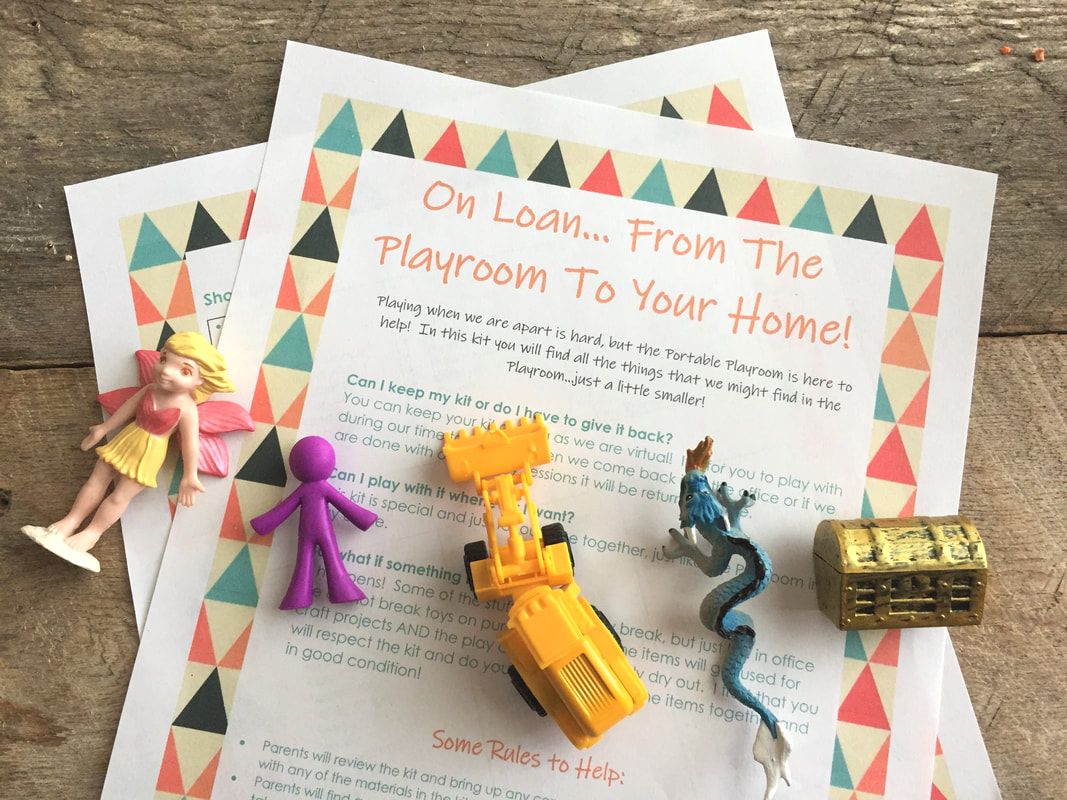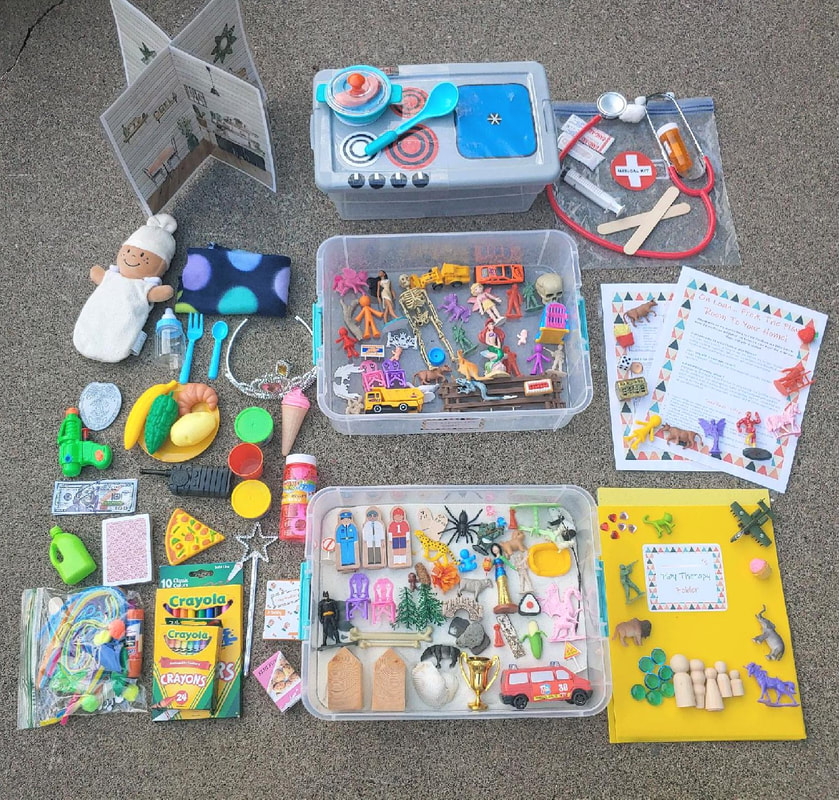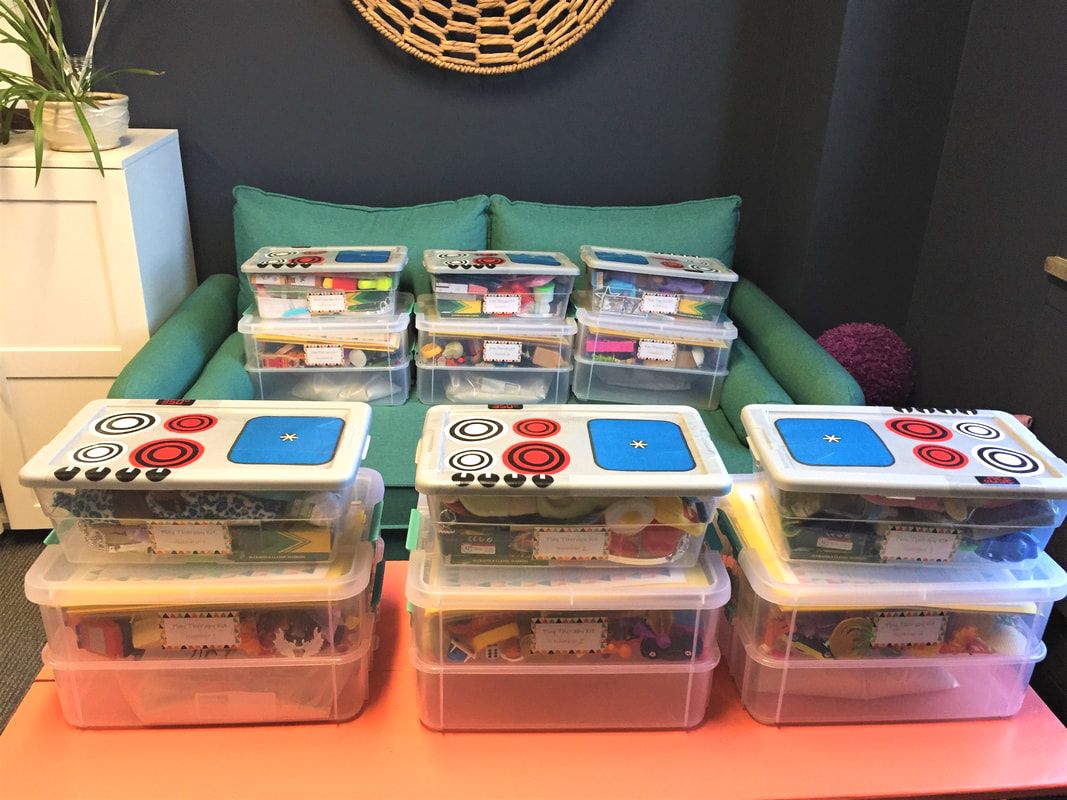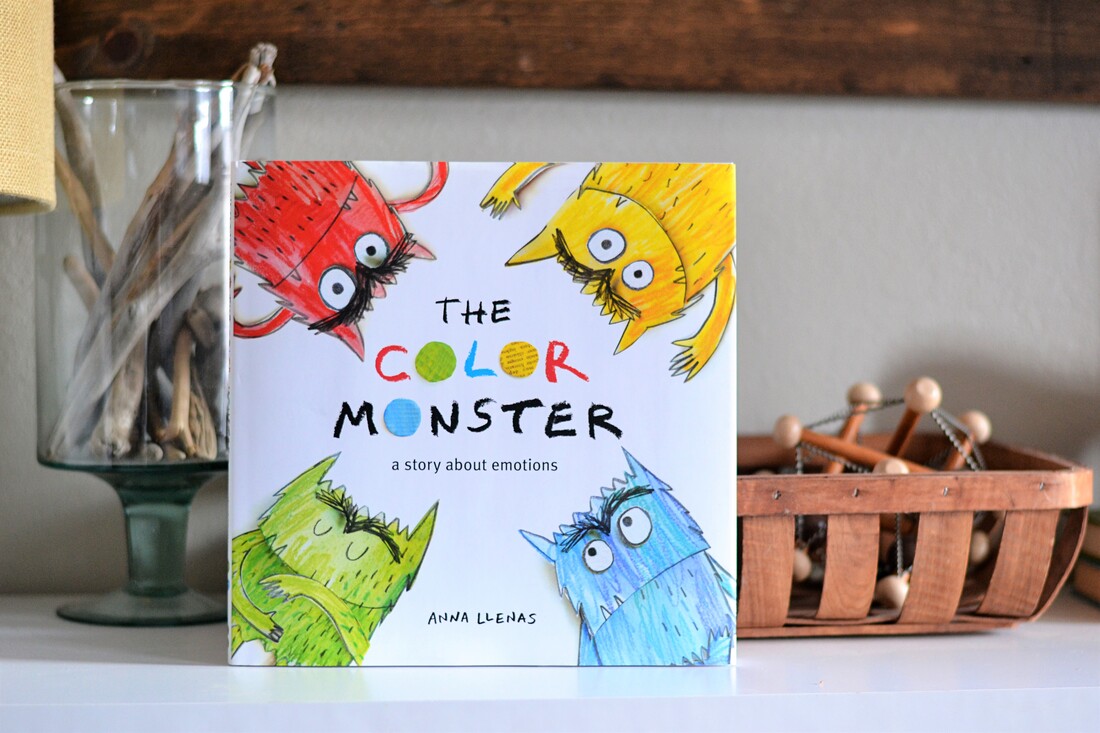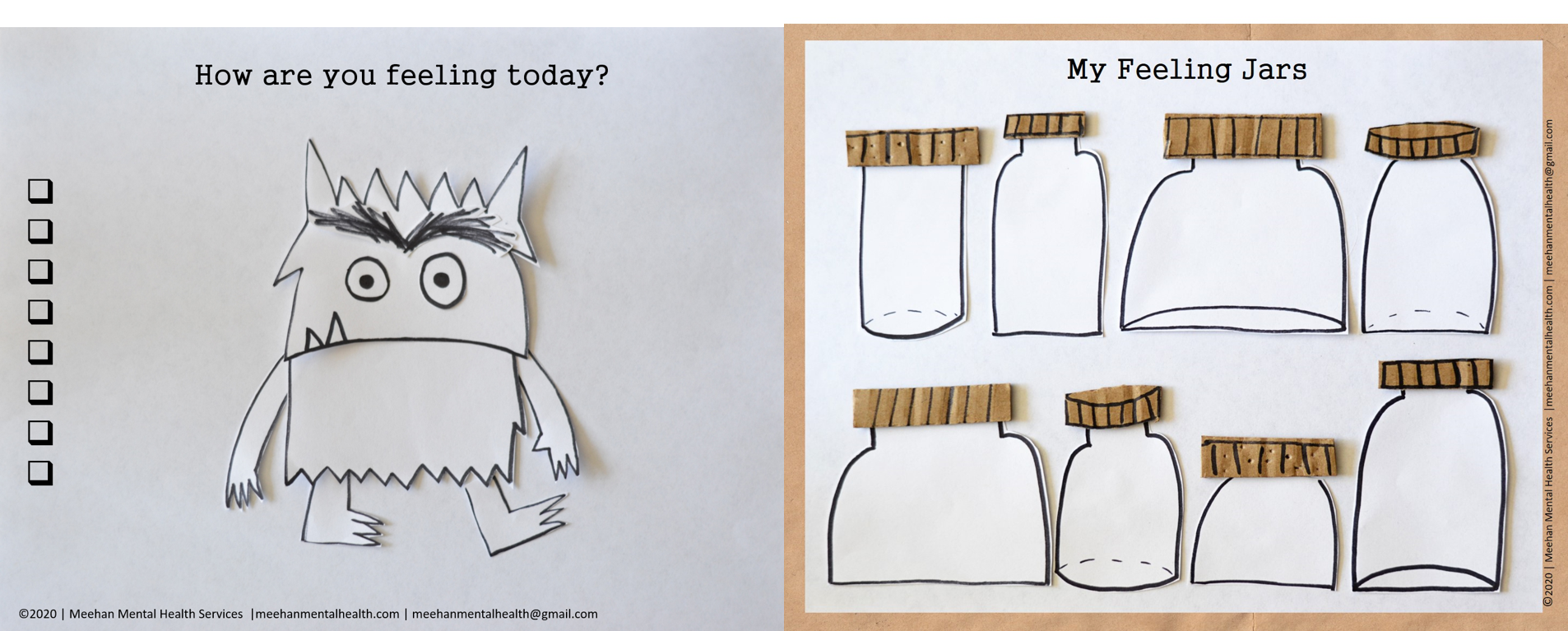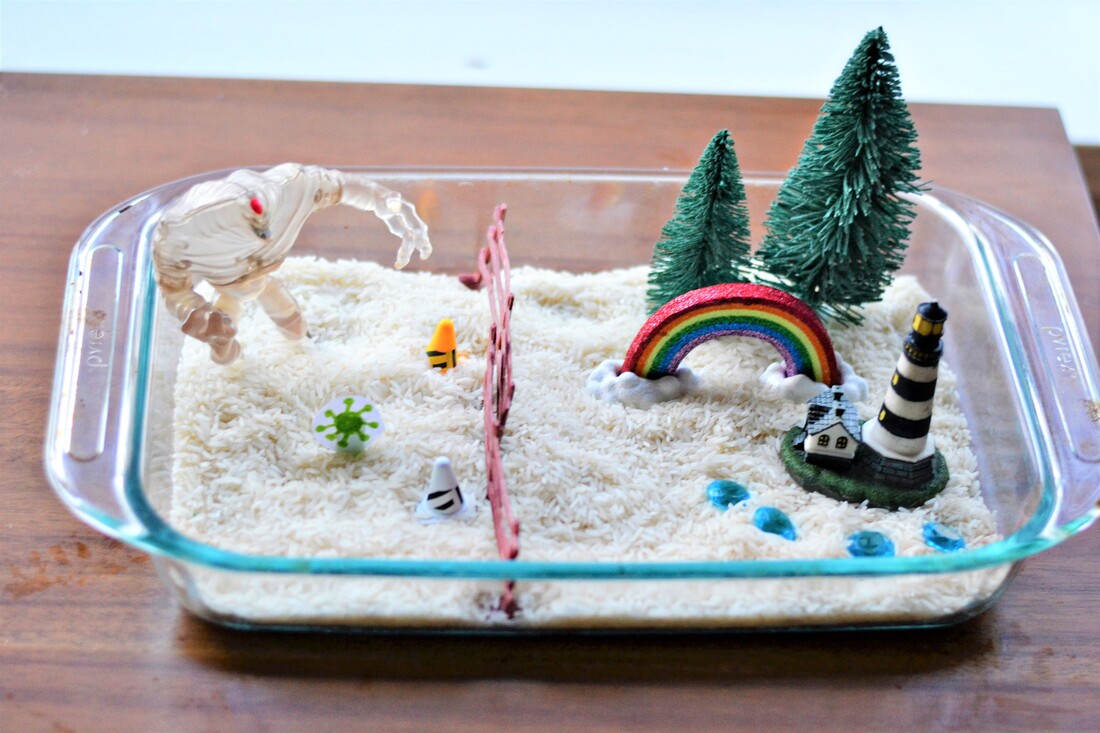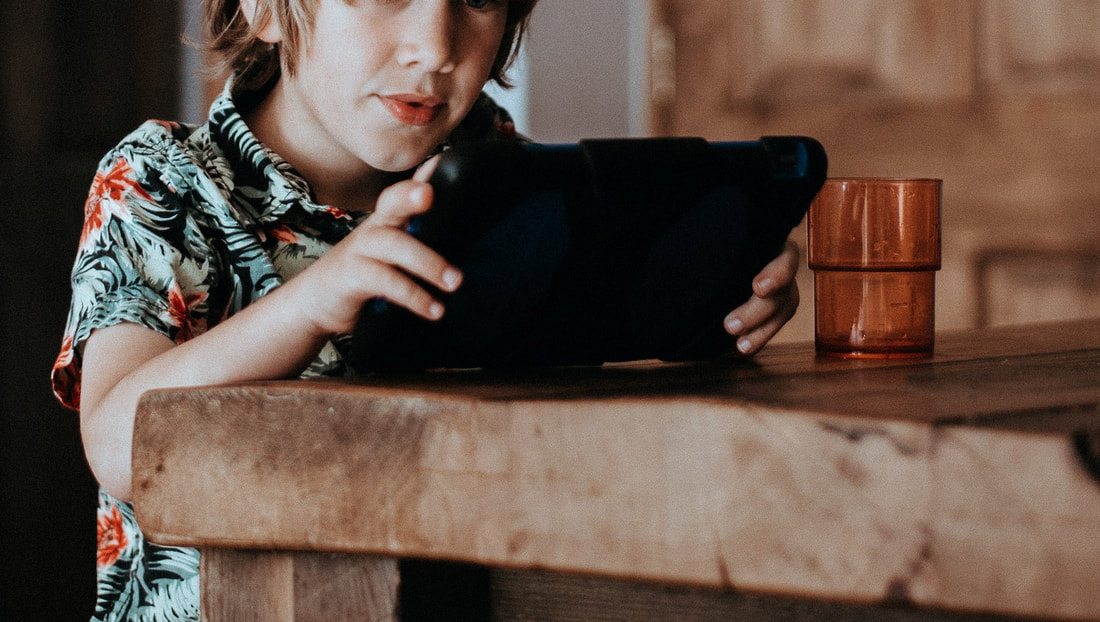|
When you are teaching parents and clients a new skill or regulation technique, how often do they come back to the next session and say it didn’t work?
Oh good, it’s not just me then!
0 Comments
When creating my Play Therapy Kits for my clients, I wanted to make sure to provide solid structing so children and families knew what to expect and what they could (and could not do) with these kits. I knew I needed to set important boundaries and limits, and at the same time also establish permissiveness. I didn’t want families to feel anxious about holding and keeping the kits AND I didn’t want half of the items to make their way under beds, in personal toy collections, and in couch cushions. This was a lesson learned when some young people got so excited about Play Therapy kits earlier on in virtual work that some of the items got used before the first session. AND I also learned that manila folders (that I sent out my first kits in waaaay back in March) weren’t as durable as I’d like. To create that balance I wanted to express something like…”you may do almost anything with these toys during our time together, but you may not add these toys to your personal collection OR play with them between sessions”. Knowing exactly what to expect and structuring statements are essential for Child Centered Play Therapy and I wanted to carry some of those same principles over to the virtual Play Therapy kit. I wanted these boundaries to re-create some of the things that were unique to my Play Therapy office, such as clients only playing with my specific toys for therapeutic purposes. I wanted to avoid any meaning attached to toys from prior play AND any play that might continue without the safety and security of the Play Therapy relationship. Think along the lines of a client continuing a therapeutic theme after the camera shuts off and a sibling storming in and taking their toys OR a parent or sibling coming in and trying to direct the play. Even though we create rules and structure around this, it seemed to be a lot easier to achieve with the containment of the actual containers and several rules and boundaries about the Play Therapy kits. I came up with three of what I thought the most frequently asked questions parents and children may want to know like “What if something breaks?” and “Can I play with these kits whenever I want?” and gave specific and clear answers. To create permissiveness I detail that just like in the Play Room toys may break, art supplies may get used, and the Play Dough will definitely dry up. Ethically it was also important to me that clients not feel financially tied to the kits. Like if something breaks there is no pressure, need, or expectation to replace anything. Just like if equipment or toys break in the office (and they sure do) it is definitely an expense of doing business and I didn’t want clients (or let’s be honest their parents) to feel responsible in any way if that happened. AND I didn’t want that to trickle down to how they may play with the toys. I also wanted to create an atmosphere of trust and discussed that I trust that clients will take good care of these kits while they are away. I also detailed out items that were included in the kit on the back incase an odd toy turned up here or there, it could make its way back into the kit. Also, for practical reasons, I have a sneaking suspicion I may be keeping these kits for a while (through the pandemic and integrating back into office). It is likely that when clients transition I will need to re-stock kits and this list will help keep me sane regarding what needs to be added back…again definitely the Play Dough. If you want to grab a copy of my Play Therapy Kit Bundle download your free copy HERE! The bundle includes a copy of the parent handout that orients to the kits with some rules, frequently asked questions, and an inventory kit. I laminated mine for durability. I also included a copy of my graphics for numbering my kits AND the stickers I used to label the personal Play Therapy folders! The labels were printed on Avery 15264 Labels (3 1/3'' x 4'') BUT you can also print on paper and just tape onto folders too! I have included both the PDF copies and editable. Sometimes with the editable the format can be off or fonts so make sure you have Century Gothic and Ink Free fonts. Let me know how you are orienting your clients to Play Therapy kits – drop a comment below! Let's Connect - click here to join my email list!
Playing while apart is hard. Playing together with masks and cleaning procedures is hard. Playing is pretty hard in general right now. To make it a teensy bit easier I put together a Portable Playroom In A Tote for my clients to use for play therapy sessions at home. It is a comprehensive play kit that is just a bit smaller than the actual playroom. One that fits in a tote, bag, or rolling suitcase for portability. One of the most frequent questions I get asked by new play therapists is about what toys to buy, most of the time on a budget. It is a struggle as a new play therapist to get a feel for what “should” be in the Playroom while balancing a pretty non existent budget. When it came time for me to start developing Play Therapy Kits for my clients (I talk about the process and pros and cons HERE) I felt like I was starting all over again. I flashed back to my early days of trying to cobble together something that was comprehensive, but feeling very overwhelmed by the 80+ toys that are recommended for Child Centered Play Therapy. Back I went to hours and hours of internet searching, scouring multiple Dollar Tree locations (because not every store has the same darn stuff), and attempting to match, to the best of my ability, the lists and categories of what my young people may need in a portable Playroom. It was definitely a lot of work, but easier this round than last. This kit I created for my clients is pretty comprehensive and includes all categories from Garry Landreth’s categories of toys in his text HERE on Child Centered Play Therapy. Categories of Real Life Toys, Acting Out Aggressive-Release Toys, and Creative Expression and Emotional Release. The kits are also not gendered and they are nearly identical. There is no “boy kit” or “girl kit”, because we don’t want to make assumptions about what a child may or may not need to express themselves. My female identified clients get the scary monsters, army toys, and trucks, and my male identified clients get the dolls, bottles, and princesses. In his text Play Therapy: The Art of The Relationship Garry Landreth also has a toy idea list for a “Tote Bag Playroom”. A lot of those items are included in his kit, however there are many additional items that I selected due to what I find the children I work with are drawn to most. There is also the addition of Sand Tray and miniatures (which represent the categories above as well as Sand Tray categories for miniatures) also making it a larger and more comprehensive kit. Lastly because I also do Cognitive Behavioral Play Therapy I included more directive items such as cards, a dice, stickie hands, and a folder for art and projects. However, as we know those items can also be used to do almost anything a child may want. So without further ado here is the source list for the comprehensive Play Therapy Kits: Containers: Shoe Box Tote *these appear to be out of stock but most Target, Walmart, or Dollar Tree stores carry these for around $1.00. Make sure the top is flat if you are going to create a stove on top. Check out this link HERE for a free printable to turn the top of the shoe box tote into a stove! Sand Tray Tote *If you wanted to only have one tote this would likely fit it all BUT the top isn’t flat enough to be a stove, so if you want a cooking area you might print and laminate a sheet of paper to just sit on top or the floor. Grab a set of free downloadable and printable labels for kits HERE! Orientation Handout: I created a handout to orient parents and children to the Play Therapy kits including frequently asked questions, a list of rules, and an inventory. Grab your free printable (and editable) copy HERE! Sand Tray and Miniatures: Check out this post HERE for a comprehensive list of sources for all the miniatures and sand. I included a dice in the miniature but BUT it is a great took to take out and use for Cognitive Behavioral Play Therapy. Also, if you are transporting the sand tray, store the sand it a Zip Lock bag…trust me. Toy Tote: Dish/Pot and Pan set *these have enough for silverware, a cup, and a plate for 4 kits. They only had a pot/pan for 2-3 depending on what you want in your kits, but the Dollar Tree had a set with a frying pan, egg, knife, and spatula all for $1.00 so I purchase several to supplement. Princess Kit (crown, wand, ring in a 10 pack) *For the price and number of items you get, these were much cheaper than the Dollar Tree, where it was $1.00 for one crown Babies *I LOVE that each of them has an outfit you can take off AND that they are multicultural. When I purchased they were $28.00, so watch out for a sale! The Dollar Tree also has plush multicultural dolls, but they are all female. These come in both gendered/neutral colors and the Dollar Tree ones are in dresses and not infant like. Glue Sticks, Markers, Crayons, Play Therapy Folders – at Target on discount for back to school, the BEST time to refill your art supplies! Baby Blanket *I cut up one yard piece of fleece to make over 10 blankets. You can choose any pattern or hit up a sale at your local fabric store! Doctor Kit (Stethoscope, Syringe (Dollar Tree 4 pack), cotton ball, tongue depressor, band aids (make sure if they are “skin color” all skin tones are represented. If not characters are great!), and medicine bottles. If you are only making one kit a used (empty) medicine bottle from your home or a friend/family member will work great!) Toy Gun Food (9+ items per kit) Play Money *The Dollar Tree also has play money Baby Bottle *these are meant to be party favors but you can get a TON for a great price. I had my husband drill a hole in the nipple of the bottle to make that part less of a choking hazard, even though it is fairly big. You could also hot glue the whole thing together! Printable Doll House *I designed a pop up free printable doll house that I laminated with a bathroom, bedroom, kitchen, and living room. With laminated sheets it is also super wipeable. Stay tuned for the link for the free download! Dollar Tree: Playing Cards (2 pack) Police Kit (badge and walkie talkie) * I choose to purchase these for the walkie talkies but decided to leave out the guns that came with it because although bright orange they appeared a bit too realistic Bubbles (3 pack) Pom poms (multipack) Play Dough (8 pack, 2 per kit) **Check out this post HERE for miniature items that also came from the Dollar Tree Materials from my office: I have a big craft supply at my office so I dug into the stash as well as my treasure chest for these items. Balloons Stickie Hands Pipe Cleaners Popsicle Sticks Googly Eyes Construction Paper 2 Envelopes 2 Paper Bags The Breakdown: Each kit comes in 2 containers, around 170 individual items and cost around $75.00 per kit. The great news about these kits is that I wanted to make them as comprehensive as possible so I did include a lot of stuff. It was an investment I was willing to make in my Play Therapy practice as I knew I would be playing apart for some time, and then when returning to office still likely using the kits for the first bit. Here are some of my kits ready to be picked up by clients! Seriously for how many hours I put into these I felt like I was giving away my first born child (I'm only kind of joking)! But seriously I am hoping this source list saves you a boat load of time if you are thinking about creating these for your clients! Both totes are labeled with numbers (ie Kit 1, Kit 2, etc.) so the matches can stay together and I have a list of what client is in possession of what kit. Also, the awesome thing about this source list is it is so easy to pare down. You can select less to fit your budget. Amazon also has fluctuating prices. Sometimes if you keep an eye on something and come back there will be a sale and discounted pricing. Lastly, if you are making multiple kits you can hit that price point much easier than if you were only doing a single kit, because most come in multi-packs. If you are just starting up and looking for a single kit, pair with other Play Therapists and cost share the price of the kits! Have you started the journey of Play Therapy Kits? What is your most loved item in the kit? Let me know in the comments below! Want to know more about setting up your play therapy office or practice? Check out this training HERE! Let's Connect - click here to join my email list!
One of the things that I love about Tele-Play therapy is the creativeness that comes out of necessity! One of the many activities I have been enjoying doing with telemental-health is playing card games virtually as a Cognitive Behavioral Play Therapy activity for my sessions and admittedly I have really settled in to playing the "old fashioned" way - with real cards. What you need for this activity is to each have the same set of cards or same game at each location. I have been surprised to find that most families have UNO (one of my faves) but nearly everyone has a regular plain old deck of cards. Now, mind you, they might have creative or ummmm interesting designs on the back – and it has become one of my favorite parts to check out and compare designs. When you are playing cards virtually, instead of laying the card you are playing face up on the discard pile, you hold it up to the screen on your turn until the next person "plays" their card. Then, when the next person has their turn they hold up the card to the screen while you select your next play. Pretty low tech, but works extremely well! I developed the game "Strengths and Struggles" (or you could call it strengths and stumbles....sunshine and struggles, really anything) based on the game of Crazy 8's. Not sure how to play? Here are the instructions - straight from Bicycle Cards! I also don't keep score at the end I just start a new round. So here is where the therapy part comes in - every time you change the symbol you need to say something according to the "therapy rules". If you change from red to black you need to say a strength you have and if you change from black to red you need to say a struggle or a stumble. Let's define strength and struggle a bit deeper. A strength can be a trait, characteristic, choice they made that benefited themselves or others, a choice they made that was hard but they did it anyway, and on and on! Maybe they cleaned their room all on their own! Maybe they let their sibling sit in the front seat even though it was really their turn. And just maybe they worked really hard and completed that art project or story they were working on! A struggle or a stumble is a time where they didn't make a choice that worked for themselves or someone else. This could be a time they didn't do a chore and lied about it, a time they got frustrated at their sibling and yelled, or a time when had anxiety thoughts going over and over in their head and weren't able to reach for a skill. The great thing about struggles and stumbles are they are GREAT opportunities to learn and getting up is part of the journey. Now, here's the thing. YOU as the therapist also have to follow the therapy rules on your turn. This is an excellent opportunity for modeling! You want to make sure that your examples are kid friendly. You miiiight not want to use things that are too adult or will go right over a child's head like taxes or mortgage payments. You also might want to soften things a bit. If you got angry in the car about being cut off and started yelling (like really loud), you would definitely not detail the whole incident. Keep the focus on the child and what they might benefit from hearing. You might soften to feeling angry and not using your skills of deep breathing as a stumble. Most kids can relate to that! For some, you may need to brainstorm a list of things you might say for successes and struggles to avoid the blank stare look and confusion when it is your turn. That totally misses the point of validation, normalization, and modeling that can come with this activity! There are so many great moments to introduce skills, challenge cognitive distortions, normalize, and provide psychoeducation (among other things) with this activity! AND you can flex it, bend it, and get creative! Sometimes children develop the best set of unique "therapy rules" - so it is definitely an adaptable approach! What are your favorite "therapy rules" for therapeutic games? Let me know in the comments below! Let's Connect - click here to join my email list!
If anyone asked me what my practice was going to look like for Play Therapy and EMDR in 2020 this wasn’t exactly what I had envisioned. By this I mean – not in my wildest dreams did I imagine that I would be doing therapy 100% online with clients and spending a good chunk of that time in a makeshift office in my garage. If you know my story you know that telehealth was part of my practice before COVID-19, BUT nowhere near all of it, and the shift to all the activities, consents, procedures, and paperwork all at once was difficult! As we are all settling in to Tele-Play for some of us this will be the platform that we use for the foreseeable future. For others integration back into the office and sanitizing toys, ohhhh ALL the sanitizing, is the next chapter. I think we can all agree that Tele-Play is here to stay in one form or another – either for clients who aren’t comfortable and/or have a pre-existing condition where they do not want to risk being in the office or *the way I hope it will be* integrated into normal practice as a way to increase consistency when life happens. Sibling sick and can’t be left at home? Tele-play! Unable to make it into the office because of work schedule? Tele-play! AND if you are from a snowy state like me – blizzard? Tele-play! So inevitably you have run into some of the difficulties, mishaps, and frustrations that can happen with Tele-Play. Maybe you have gone on a bike ride with your client, jumped on the trampoline, had a tour of their whole house, or had to set a limit about not taking you into the bathroom. A recent blog comment by Ashley reads “What if they run out of the room? What if they turn off the camera/program? What if they take the device and go on other programs? What if they don’t listen to what I say? [When a client leaves the room with permission] will she come back?” These are all great questions and I felt they deserved some more thorough attention! Okay let’s break it down! What if they run out of the room? What if they leave with permission but don’t come back? This is where policies and procedures are key! All of these procedures are discussed in detail with clients and parents before starting sessions. Did this sentence just make you anxious because you have no idea what I am talking about? No worries – you can introduce and orient to these at any time! So one of my rules is I always have my business cell phone within arms reach. I have whatever parent/guardian is with the child at the time of the session’s phone number. We have agreement that they will be able to be reached immediately at any point in the session. I also have an agreement that if a session gets interrupted for any reason (tech down, the kid running out of the room) and cannot resume within two minutes (longer for things like going to the bathroom) I call the parents and have them support re-engagement. What does re-engagement look like? It depends! One of the biggest things to consider is, if this were your office how would you handle these behaviors? Some therapists might meet the child where they are and just be present in the waiting room. Other therapists would give the child space. Still others would set a limit stating that choosing to leave the playroom is choosing to end the session and engage with the parent for the last portion. The key is to work within your theory or framework and identify the function of leaving. For kids that just get excited and distracted sometimes it might work to have a parent camp out outside the door and issue gentle reminders for the child to stay in the room. For others who are dysregulated or have some apprehensions or anxieties about engaging then there are more complex elements to consider. You need to pair with parents and work to have the parent as an external co-regulator for the child. What if they turn off the camera/program? What if they take the device and go on other programs? What if they don’t listen to what I say? Now the questions above were about keeping the child in the room, this next set of questions is how to engage with the child when these problems come up during session. I promise you these things will happen – the camera gets turned off, they exit out a program, or they are just plain old playing video games or Minecraft during your session. Ugh. The first lens I look at is “Is this behavior therapeutic”? Take the example of the child who wants to feel in control, a child who feels distant from you, or a child who feels abandoned. Could play themes come out of turning the camera on and off? You bet! Your theory depends on what you do next – tracking, creating an activity around this dynamic, etc. Now, this may or may not be different if the child is turning off the camera to hide something. Could this be similar to a client who goes into a tent in your play room and doesn’t want you to see what they are doing? Yes! However, sometime it means a client is doing something they should not be doing both in the playroom and in the context of their home environment. For this type of behavior a limit would need to be set. This might include those policies and procedures of contacting parents and having them create the structure to enforce limits within the session. Now, there are some ways you can tell if a client could be going on another program. If there are different lights flashing on their face, if their face is close to the screen but they are distracted, their eyes are going back and forth and are not set at a steady gaze that we would expect if they were paying attention to you on the screen, their affect (excitement or defeat) does not match the context of the therapy setting, or if you hear rapid typing. For teens old enough to have a cell phone, this could be looking at their lap frequently. Does this always mean they are on another program? No – unfortunately there is no fool proof way to call out this behavior. With this, I usually start with a wondering or noticing of what I am observing. Then you can create some tweaks – such as having them sit far enough back where you can see their hands OR having a parent come in to ensure that all other programs are off. I am told that there is a way that a parent can lock the child onto one screen, but honestly I haven’t ever used this method so that might be some digging on your own if you have a client where this is an issue. Lastly – what if a client just refuses to do what you say? Well…..doesn’t that happen in our offices too? I hope it’s not just me! So - how you handle it depends on your theory! Sometimes this behavior comes from a hypoarousal state where the client doesn’t want to do anything OR sometimes it comes from hyperarousal state and they are having behaviors from a flight/fight response. These behaviors typically may need limits at some point. I tend to pull limits in a bit sooner in Tele-Play due to the potential if there is escalation to need to call parents into the room and the lag that it may take from calling to parents present. This is different from in your office when you can immediately and physically be present with the limit. Limits might look like “One of the things we cannot do during our time together is break your toys, but you can do almost anything else that you would like!”. I like the limit setting process from the book Child Centered Play Therapy by VanFleet, Sywulak, and Sniscak where after stating the limit (in the example), if the child is not able to comply you state the limit with a warning. If the child still does not comply then you enforce the consequence from the step prior. In Tele-Play this might look like the child’s time during the session ends and you continue the rest of the session as a parenting session. Wheew! That was a lot AND I hope it got you thinking about how in office troubleshooting of problems can be translated to your Tele-Play sessions! Let me know in the comments what the biggest Tele-Play obstacles you have overcome (without any client information of course!) and how did you do it? Want to learn more about specific Tele-Play Therapy techniques? Check out this training HERE! Let's Connect - click here to join my email list!
Sometimes feelings get…all tangled up. This can be confusing and sometimes we need help untangling them and sorting them all out. Enter “The Color Monster” by Anna Llenas! This book is AMAZING and as I talk about here and here bibliotherapy is such a wonderful practice that is so adaptable to provide as a therapeutic approach in all sorts of settings – office, in home, at school, and of course Tele-Play! This book is a wonderful story about a “Color Monster” who is full of mixed up colors and emotions. A little girl takes the monster by the hand and gently helps the Color Monster untangle and separate out all of these feelings and put them into jars. The level of compassion in this book is SO wonderful. One of my favorite things to tell young people is that feelings aren’t good or bad – they are just our bodies way of letting us know what is going on in the world around us! For a lot of the littles (and teens too) that we work with there can be a lot of judgement that comes with anger and a portion of the therapeutic work can go towards decreasing shame about this real, normal, human emotion. This makes sense as to why my most favorite line in the book is “Sometimes, you want to take out your anger on others. But I’ll be nice to you, Color Monster, and your anger will disappear!”. My heart just melts on this page! The book also emphasizes being able to feel and honor whatever feeling comes up and tell us that it is OK to feel all of these feelings, it is okay to listen to our bodies, and it is okay to cry! So powerful, especially for young people who often get flooded and want to repress feelings. Another thing that is just fantastic about this book is the use of metaphor. It compares anger to a fire you might want to stomp out, sadness to a rainy day, and calm like leaves swaying in the wind. If you are doing any sort of metaphor work with kids this is a GREAT book to get the wheels turning! When I am reading this with young people after I will pause, ask them what they noticed, and most of the time go into a Cognitive Behavioral Play Therapy activity about feeling identification and levels! I have included a free download of these worksheets HERE! I had so much fun creating these printables and thank goodness for all the Amazon packages I have been getting lately - there was no shortage of cardboard for this project! So, after we read the book I have them select colors (up to eight - but let's be honest you could add more boxes and print a duplicate of the feelings jar page if you needed more) and color code and write in what feelings came up for them today or in the week using The Color Monster Check In download. The book identifies five feelings of happy, sad, angry, fearful, and calm, but I wanted to make sure if other feelings came up there would be space for them so I included eight. One thing to notice is how the feelings are being drawn. As opposed to a color your heart activity (where the feelings are separate) the Color Monster’s feelings can be mixed up. Are some feelings darker (like pressed down harder when drawing) and what feeling are more prevalent? Do some feelings have just one line and are there obvious feelings that are missing? Do the feelings spill out of the color monster and onto the rest of the page? These are all great things to notice and process along with how it feels in their bodies when the feelings are mixed up, any thoughts that might come up for the Color Monster, and the choices the monster may make when feeling all mixed up! Oh, it is also a fantastic externalizing technique! The next sheet is all about taking time to separate out and honor each feeling. With the My Feeling Jar worksheet you can clearly identify each feeling experienced and how much of each feeling. You can go deeper with young people and identify triggers, how they felt it in their bodies, warning signs of these feelings, and choices that might be helpful vs unhelpful to honor what is going on for them over the week. This exercise is also a great tracking technique. If you engage in this activity with clients periodically how does their Color Monster change over time? What about levels or ranges of feelings? Does their emotional literacy increase where they could initially name three feelings, but now it’s five? Now, although this activity is for younger children, teens also have tangled up emotions too! The teen version of this? This fantastic Tangled Ball of Emotions Download you can snag HERE from Sources of Strength. I have been using this drawing activity for a prompt of how teens feel currently and having them fill out a second for how they desire to feel. From that point we can spring board off into processing how to get from here to there! Here’s hoping this activity brings you and your clients some superpowers to help untangle those messy, chaotic, and confusing feelings! Want more training on how to use Bibilotherapy in your Play Therapy practice? Check out this training HERE! Let's Connect - click here to join my email list! *This post contains affiliate links, so I may earn a small commission when you make a purchase through the links on this site. The best news? It doesn’t cost you a penny! Thanks for supporting my business by shopping my favorite playroom gear and accessories! I like to say that I was “born for the tray”. I spent my childhood collecting actual sand from beach vacations, carrying pounds of it hundreds of miles home in backpacks on cars and planes (and through airport security), and collecting tons of knick knacks. What a wonderful surprise when I found out that these knick knacks actually were something very valuable called miniatures and I would grow in my adult life to collect hundreds of them for my job! And some of those knick knacks from childhood? They sit on my sand tray miniature shelves in my office today. When shifting to virtual sessions one of the things I have such a hard time transitioning was the power of Sandtray. There are so many great ideas for virtual technology trays like Virtual Sandtray but at $169.99 I had a difficult time committing. Other therapists have gotten creative and used a Whiteboard App or Paint3D for free to create visual worlds with clients through screen share. For me, while digital is an amazing alternative for still utilizing Sandtray with clients while you are engaging in Tele-Play, it was missing the tactile kinesthetic and sensory element that the sand and miniatures in office brings. I wanted to share three ways for those who are not quite tech savvy or who are also missing the sensory and touch experiences of Sandtray to continue to support clients virtually. Your Own Tray For this option you literally use your own tray or portable tray and your own miniatures. A major benefit to this is that the children you work with are already familiar with your miniatures and may find comfort, meaning, and metaphor in using miniatures that they previously used in office. You as the therapist manipulate the sand and select the miniatures and placement – all dictated by the child. Joel Lambrides an LPCC and RPT from Minnesota shows an amazing video of how to set it up HERE! He uses a brilliant fixed camera system (cell phone) that can be placed over the tray to create an aerial view. Another take on this would be a two camera system with a Telemedicine platform that could have more than one “client” where the therapist has both the phone fixed over the tray and another device to maintain eye contact and communication with the child. Draw Your World I first talked about this technique HERE. For this type of Sandtray have the client or parent tape together four sheets of computer paper in a rectangle. You can have the client start out by drawing what kind of ground the “tray” will have on the paper. Will it be grass, rocks, lakes, rivers, mountains, or volcanoes? The sky is the limit! Then, do your sand tray work as usual adding in miniatures to tell the story and create the world. I love this technique because it allows clients to be in control and touch, place, and re-arrange the world. How do clients gather miniatures? Don’t worry – keep reading! I have you covered below. “Sand” Tray Okay – I saved my favorite for last! For those that know me know that I started out my Sandtray journey with a tray of corn. I have experimented over the years with other mediums besides sand to create trays and have enjoyed seeing the different dynamics that come out with each. SO as I was brainstorming how to help clients get not only the movement and placement control (as with the technique above) I also wanted them to have a sensory experience of sand as well. Do you know what feels kind of similar to sand AND most families either have on hand or can get for a reasonable price? RICE! Most families also have some sort of casserole pan or cake pan – thus the “Sand” Tray of a casserole pan filled with uncooked rice was born! Now – on to the miniatures! Selecting and Creating Miniatures Most clients have some sort of miniature collection in their house. These could be action figures, toy soldiers, princesses, or if they are like me – knick knacks! I give clients a list of the categories of toys and encourage them between sessions to go on a hunt for minis. I also assure clients that although it can feel overwhelming they really only need a couple of things for each category. I encourage clients to get creative, go outside, and have an eye out for all things mini! Now, there are definitely young people who would only be able to find a select few items in their home. That is totally fine! For these children we create! You can spend a session having the client draw figures they want to be in their tray on paper, finding pictures from the internet to print out, or using stickers. You can adhere pictures to small card stock rectangles (with a bit behind for support and a bit sticking out the bottom) or small pieces of popsicle sticks to get them to stick in the sand. For some young people they may need the supervision and help of a parent for cutting out and pasting/taping. For the young people that draw their world, create a flat base on the bottom with paper – like this genius method HERE! I created a free handout explaining the Draw Your World and “Sand” Tray technique that you can grab to share with clients HERE! What are your favorite ways that you have used the power of sand in the virtual world? Drop a comment below! Let's Connect - click here to join my email list!
As we are all adjusting to this new “normal for now” season of social distancing and sheltering in place it is important to get clear about how to support one another and regulate through these difficult times. I wrote HERE about all the different response young people may have to COVID-19, which quite frankly was A LOT of different ways young people might react and process this pandemic. So now you might ask – what next? What do we DO now (besides of course movie marathons)? I’m glad you asked! Below are some ways I have been talking to parents, guardians, and families regarding how to support their children during this time! Assess Knowledge and Give Age Appropriate Information: Let’s ask children what they know about COIVD-19. They likely know some things and this is a great way to open up a conversation and to be able to assess if they have accurate information OR if they have thoughts that are maladaptive. These conversations can happen in therapy sessions or within family conversations. There are some great tips for parents HERE and HERE for how to facilitate these conversations. One of the most important things to know is that as adults we need to manage our anxiety when talking through these difficult topics to create a safe space for kids to explore their own feelings. Children need to know age appropriate information about what is happening in the world around them and in trauma. Honestly if we don’t give it to them, they will find out about it from someone else who may or may not have accurate information. If parents or therapists are able to facilitate an age appropriate discussions, safe adults control the flow of information – not the next door neighbor who heard something from his cousin who heard it from their best friend, or who knows where else! Also – children will just plan old MAKE UP information if they do not have accurate information – and not necessarily consciously. One of my favorite Deb Dana quotes is “story follows state”, meaning that we create stories and assign meaning to our dysregulated nervous systems. It is also important to not just have one conversation about COVID-19 – this is not a one and done topic. Find the healthy balance between flooding children (ie bringing it up multiple times per day) and avoidance (no conversation). Checking in from time to time to see what questions they have or updating on information is essential. Below are some resources to help explain and process COVID-19 with children: National Child Traumatic Stress Network Parent/Caregiver Guide To Helping Families Cope With COVID-19 The Story of the Oyster and the Butterfly: The Corona Virus and Me – Free digital book to help children understand COVID-19 Come Inside Bear – a children’s story about social distancing Our Hero Is YOU – Free digital book to help children understand COVID-19 Assess and Support Family Stress: As much as I love a good parent check in, I have been taking much care to check in more so with family systems these last weeks and will continue to do so. I strongly believe that parents are the most important people in their child’s lives, and now more than ever, they are holding the container and structure for their child’s wellbeing. The concept that you need to put on your own oxygen mask before you help others and as mental health professionals is so important, because we need to make sure we are supporting and regulating the family system so the system can regulate the child. This might mean extending sessions or adding additional sessions in the week to make sure families are getting the support they need. Validate and Express Feelings: All feelings are OK! I love to say that our feelings are our bodies compasses for what is going on in the world around us. This is also along the lines of Dr. Dan Siegel’s “Name it to tame it” concept! There is also so much grief and loss in COVID-19, beyond the physical lives that will be lost. The play that never was performed, the vacation that was cancelled, the graduation ceremony that was missed, and the grandparents that can’t be squeezed. Emotions will cycle, things will become repressed and “come out sideways”, and sometimes things will feel stuck. As adults it is also so important that we model these feelings for children. That we can own, talk about, and name the feelings as well as show children how to regulate in a way that is helpful. I am having a lot of conversations with families about practicing relaxation and calming techniques together as part of the routine. This might include deep breaths, family game night, walks, a family gratitude practice, meditation, or dance parties! Routine And Structure – But Not Rigidity: I love the saying “trauma is chaos structure is healing” and I have used that quite a bit these last couple weeks. Creating a routine and consistency, and continuing with routines already in place, can significantly benefit our nervous system by letting it know what to expect. There is definitely comfort in routine. In addition to a schedule that is visual, it might be really helpful and necessary to go over this with children verbally at several points through the day. Get to the point where children roll their eyes and say “I know, I know” – this is the sweet spot where they know exactly what to expect! On the other hand, step away from rigidity and have realistic expectations of what might be accomplished in the day, knowing that our nervous systems are all on high alert likely leading to those things I talk about HERE including anxiety, anger, fixations, rumination, etc. We will likely not be at our most productive and running at optimal performance – and that is okay. Children (especially because we may be spending more time in our brainstem where it is really hard to learn anything new) will likely not be taking up basket weaving, mastering a new language, or excelling at gymnastics during this time. Identify the bare minimum, good enough, and go with that. It is also okay if you are 10 minutes late for lunch, need to shorten the hour bike ride to a half hour, or wake up around breakfast-ish not at 6am like planned! Everyone in this time needs a little grace. Physical Distance NOT Social Distance Even though we can’t occupy the same physical space as others it is so important as humans to connect with one another. What were the activities that children were engaging in before COVID-19? Can we get creative and move some of these online? I have seen AMAZING things with transitioning to all virtual Play Therapy BUT am also seeing other communities rally as well! I have seen virtual dance classes, karate, choirs, and occupational therapy! How can we help children connect with others through video chat platforms, community challenges such as this free downloadable Lego Challenge, or a weekly lunch or tea date with grandparents or best friends? Move Your Body This one I cannot emphasize enough. With all the cortisol and adrenalin building up in our bodies due to the stress response we likely all have to some degree these chemicals need to be burned off by movement. Now, these chemicals are meant to be burned off by running for our lives or fighting for it BUT dance parties, jumping on the trampoline, yoga, bike rides, and walking the dog will work too! These ones are also A LOT more fun! And as I have been saying a lot lately *with humor of course* – what else do you have to do? What are your favorite ways of COVID-19 Coping for either yourself, your families, or the children you work with? Drop a comment below! Let's Connect - click here to join my email list!
Our nervous system is constantly scanning the world looking for cues of danger or safety. Neuroception is our nervous system’s ability to distinguish situations as either safe, dangerous, or life threatening and operates completely outside of our conscious awareness. And man, our bodies are working hard! I have seen statistics anywhere from 11 million to 400 billion bits of sensory data that our bodies take in PER SECOND!
What we also know about our nervous systems is that they can “talk” to one another and provide a co-regulatory capacity with one another. In her book The Polyvagal Theory in Therapy Deb Dana states that “it is through reciprocal regulation of our autonomic states that we feel safe to move into connection and create trusting relationships”. In essence, it is the foundation of safety, which is the foundation of a trusting therapeutic relationship. OK – so how the heck do we do this when we are not meeting face to face, but screen to screen? I strongly believe that we can still provide co-regulation and safety cues from afar. Just like when I felt safe and cared for when I entered the world of Mr. Roger’s neighborhood as a child, how I instantly calm at the sound of my mother's voice on the phone or hearing my favorite song OR how I feel as though I am literally going to DIE when watching a horror movie – I believe that we can also take in cues or danger or safety through our screens and at a distance. Below are my tips on how I create safety for my clients I see virtually! Create A Secure Space Guarding the safety of the Tele-Play space is crucial. I explain to parents and children that we are going to treat our time together the same as we would in office. Just like a parent would not come into my office to drop off laundry during our play therapy session we need to orient families to take the therapy time as serious and sacred when we are engaging virtually. I know I definitely would not feel safe if my brother, mother, or grandpa were wondering around in the background of my intense therapy session. Creating a safe secure space comes from orienting clients, creating expectations, and brainstorming – what do they need to feel safe? What kind of room do they need to meet in? For some clients they may need to be on a different floor, in a room different than their own, or in a room that is locked (when appropriate of course). Oh – and sometimes they need a nerf gun, to be under a table, or in a blanket fort. All of this is wonderful! Create Structure One of my favorite statements from my training in Trauma Focused Cognitive Behavioral Therapy was “trauma is chaos – structure is healing”. In her book, Lisa Dion also refers to “the unknown” as one of the four threats of the nervous system. With creating structure we are making the unknown known. Creating structure means beginning and ending your sessions in the exact same way each session so the child knows exactly what to expect. My in-office sessions have this structure, so much so that when I am doing CCPT and making my entry to the playroom statement my clients will say “I know already”. I smile and take this as a huge victory that I have created predictability and structure. I attempt to create the same structure as I have in my office of a check in and then transition to whatever play therapy modality I am using. The 5-minute warning of our play time being over again serves another anchor point for structure. In Tele-Play sessions I have created an ending ritual of containment of toys and the “wave off” where the child goes to get the parent and we wave as we end the session. In office this usually looks like the consistency and structure of picking from my treasure box, the walk to the lobby, and the wave goodbye. Whatever this looks like for you in Tele-Play create a structure so strong that your clients can read the script for you! Regulate Yourself Just like in office therapy – if we are not present and we are out of our window of tolerance our clients will feel that and also become dysregulated. Incongruence is also a cue of danger - we can't just fake it – when you as a therapist are frustrated, anxious, or out of your window of tolerance and trying to say that things are “fine” or put on a smile our clients know that something is off and will start to become anxious or dysregulated. This is also what Carl Rogers would refer to as genuine – a core condition of therapy! So make your best attempt to figure out what you need in between sessions and during sessions to regulate your nervous system so you can be regulated and genuine. Lisa Dion is fantastic at emphasizing the importance of connecting to and feeling your body as well as discharging nervous system energy through body movement during sessions. So - does regulating yourself mean eating something crunching between sessions? Swaying and moving during your time with the child? Stretching and going for a quick walk after you click off? Deep breathing or meditation exercises? The great news is there is a gigantic buffet of regulation skills options out there – find what works for you! Send Social Cues of Safety and Co-regulation This Co-Regulation Quick Guide is ahhhh-mazing. If you don’t know Justin Sunseri and The Polyvagal Podcast – you need to! Sending out what he refers to as “safe and social cues” is really just good therapy and what most of us do outside of our conscious awareness. BUT doing therapy screen to screen you might need to up your game and your intentionality. The good news is that most of us can see ourselves on camera and we might need to check in once and a while to see what signals we are sending our clients! Sometimes we need to over emphasize a bit so they can pick up our gestures or expressions OR raise our hand gestures so they are on the screen. So the first safe and social cue I love is vocal prosody – making sure your vocal range goes up and down. In short it is what I talk to parents about having a “kindergarten teacher voice”. A flat monotone voice can actually send a cue of danger. This is why a lot of our clients will say that their parents are “yelling” at them, only to have their parent come back stating that they were simply “asking” them to do something. That monotone voice can really feel like yelling to a lot of the young people we work with. Other safety cues that are really applicable to Tele-Play are smiles, eye crinkles, and head tilts. Hear me out here – if you are in danger your eyes will be wide open, you will have pursed or flattened lips, and your head will be upright and alert. Definitely ready and activated to take on danger. Relaxed, engaged, and congruent facial expression is a cue of safety – BUT only if you actually feel this way. Remember incongruence is a cue of danger. Also a forward leaning posture can send a social cue of connection, so you may need to figure out how much of your body needs to be seen on camera for clients to pick up these social cues. Lastly - safe, soft, and empathetic eye contact (as opposed to a piercing stare) happens staring directly into your computer's camera. A bit awkward as it prevents you from fully taking in your client's social and facial cues BUT really important for them to see you looking at them. The Scenery Because our nervous system takes in so many bits of sensory data per second (see above) visual clutter can be overwhelming. Make sure what your clients see is neat and tidy and if you can go with a wall color that is light and soothing like greens or blues and stay away from bold or activating colors (like orange or red). Tapestries are also an awesome and inexpensive way to create the scenery you might want to hang in the background. Any elements from you can bring in from nature are a huge bonus and if possible use natural light. Art is also really important and pictures of water or nature will have a regulatory effect! So that’s a wrap of my favorite ways to create safety in Tele-Play sessions directly from Mr. Rogers, The Polyvagal Theory greats, and trial and error! What are your favorite ways that you are creating safety in Tele-Play sessions with clients? Drop a comment below! These are definitely uncertain circumstances and uncertain times in the world at large, and the world of Play Therapy. When our clients are at their most vulnerable, we have decisions to make about the best ways for us to show up for our client’s and provide this service. AND these decisions are much more complicated than a therapist shifting their practice to virtual sessions under almost any other circumstances. Conversations with clients this week have been on a continuum of concern to sheer panic, but one common theme of uncertainty united them all. Change of routine, as schools in Minnesota have closed, and much fear about underlying health conditions for children themselves, siblings, family members, and friends that may place them at risk should they be infected with COIVD-19. Uncertainty of how long this will last, disappointment about cancelled events that young people have worked SO HARD for, such as concerts, sports seasons, and class trips, and frustration with not being able to see friends. There has also been much confusion and difficulty understanding WHY things can’t be normal. In all this time of uncertainty the consistency therapy provides can be a safe harbor for our clients to begin to unravel all of these complex emotions. This week I have reflected significantly on what my clinical recommendations would be for clients as I transition my practice fully virtual in an attempt to do my part for both myself and the families with whom I work with to social distance. The great news is that all clients have autonomy over their mental health care at all times. I can offer what I believe to be the best recommendations for their mental health treatment, and they have the option to take it or leave it. I in no way want to spread fear, as there is plenty of fear and panic in the world right now. However, I do not want to be ignorant as I am watching the COVID-19 pandemic unfold across the world. I think we need to get real and honest with ourselves and our clients. This is not a one or two week break. Schools are talking about being out of session until the end of the year. And if I am thinking about the impact of this time frame on someone’s mental health services, this is a significant shift in their therapeutic care. As I sat and thought about each of my client’s mental health needs, I reflected on the question – do I believe that our current pace of therapy is medically necessary? How would I (for any other reason) respond with therapeutic recommendations for a client that wanted to take a 2-3 month break from therapy? What would be my ethical duties to inform them of what that might do to their mental health? For most of our clients, we would likely say that this amount of time without service would be detrimental to their mental health and progress. With the reality that some states have begun to require residents to “shelter in place” as well as social distancing recommendations, it is realistic to think that most clinics will be faced with the decision – virtual vs. no service. In this decision I look to the American Counseling Association Code of Ethics which states, “Counselors assist in making appropriate arrangements for the continuation of treatment, when necessary, during interruptions such as vacations, illness and following termination.” Read more about therapy interruptions and our ethical duties here. Considering this information, for those that are not able to provide services virtually there needs to be a referral for clients to continue care elsewhere should you not be able to provide that service or significant resources put in place and a plan to receive services should they decide they want to re-engage in therapy and you are not able. If I think to my nine week maternity leave – SO MUCH planning and preparation went in to making sure each client was connected with another therapist for the interim or for those who elected not to continue a specific plan was made and a referral was given should they need to see a therapist during that time as I was not able to provide them therapeutic care. I strongly believe as a Play Therapy community, our leaders should be those who have expertise in this work and who have been doing it in the field with children and adolescents. We can look to therapists such as Dr. Tillman, PhD of the Family Institute out of North Dakota who has been offering virtual Play Therapy services for 6 years to serve the remote families on her caseload that have difficulty with access to in office appointments and Lisa Dion, LPC of the Synergetic Play Therapy Institute who talks about her experience with virtual Play Therapy here and here and so many others that are offering trainings, materials, and adaptations. For those of you still taking a breath, getting clear, and deciding what is right for you, your clients, and your practice – that’s OK too! If you are not regulated and in your window of tolerance it’s ethically best to take a step back and get clear about the pros and cons of each as well as develop an action plan. So - here is the 1,000 foot view of what might go into this process as you make these decisions. Get clear on the rules: There are so many invested parties when you think about shifting your practice to Telemedcine/Telemental health. The first is what does your specific state laws and licensing board say about what is needed to provide this service? State law varies state to state for what is required to deliver this service. AND licensing boards may vary across licenses within the same state! For my state of Minnesota as a Licensed Professional Clinical Counselor my board has different requirements for where a client needs to be in the present moment (“feet on the ground”) versus other boards. Next is your malpractice insurance. I carry my own malpractice insurance in private practice and the feedback I received was that I was covered whatever medium I choose to provide therapy. However, this is policy and insurance company specific! Next consult your ethics code. See about how I went through my ethical decision-making tree HERE! Lastly the client’s insurance company may also have specific requirements as well, so even if you are able to provide this service according to your state law, licensure board, and malpractice insurance your client’s insurance may not allow you to provider therapeutic services in this way. Get Trained! With anything new according to our ethics codes, additional training and education is required. It is an amazing time to see the mental health community band together and offer FREE training of how to ethically and appropriate transition sessions to telemedicine. Some have CE Credit, like this PESI training below, and some are for your education as a therapist without CE credit. PESI is offering their course “Telehealth for Mental Health Professionals: 2-Day Distance Therapy Training” FREE with the code TELEFREE at checkout! (usually $439.99). Still feeling unsure? Think about getting supervision or consultation around this topic with someone who has provided this type of service! Get Prepared After your training you will likely know what resources you will need to pull together to ethically begin to provide this service to clients. I write about more about what you need HERE and offer a free-mini course about how to get started. Person Centered Tech also offers AMAZING resources HERE including forms, a free training video, and preparation checklists. Give Informed Consent Giving clients informed consent should be more than handing them a packet or sending them a form and asking them to sign at the end. The informed consent, especially during the COVOID-19 pandemic, allows clients and their families to make decisions that are best for them. My free course has the Telemedicine Informed Consent I use with clients. Collaborate with Clients I talk HERE about how to have an Orientation Session with clients after they transition from in office to Telemedicine. I include two free downloads of handouts to send to parents to help orient them to the technology and virtual platform. I also talk about how to brainstorm about how to make these sessions, within the home, safe, ethical, and confidential. Modify I strongly believe that providing therapy on a virtual platform for Telemedicine or Tele-Play is a modification of an existing skill set. I have provided therapy services across a wide range of settings including in office, schools, homes, and juvenile detention centers. Each of these settings needed special adaptations for me to ethically, privately, and competently provide services as a therapist. Providing services virtually is another setting with its own unique set of challenges. Much like in home we need to think about how to create a safe, private, and confidential space in their home. The additional setting challenge includes how do you provide safety should a situation arise that the child is out of their window of tolerance and you are not able to use skills to regulate or they are a danger to themselves or others. These structures should be built into every safety plan created with clients, may vary from client to client, but generally includes close and easy access to a parent and training the parent to engage in a safe ethical way when needed. With these modification bumpers in place the heart of the work remains the same. The relationship you have with the client, the core interventions, and your theory. Are you thinking about transitioning clients in your practice OR are you in the middle and finding it hard to become clear with all the moving pieces? Grab this spreadsheet to ensure you have all the proper forms and communications in place with your clients. Let's Connect - click here to join my email list!
|
Hi, there!I'm Ann Meehan, an LPCC, Loading... Archives
July 2024
Categories
All
|
Privacy Policies | Terms of Use | Disclaimer
Contact
[email protected] | Copyright Meehan Mental Health Services 2022
Contact
[email protected] | Copyright Meehan Mental Health Services 2022


